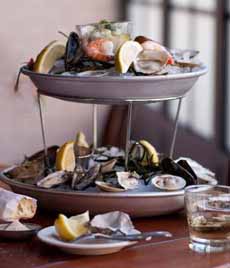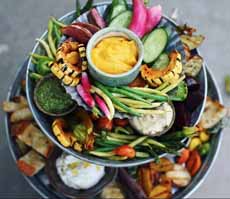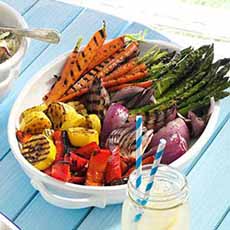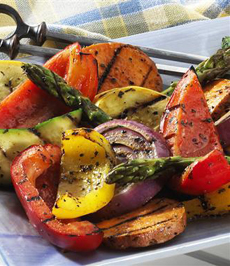TIP OF THE DAY: Plateau De Fruits De Mer For Vegetarians & The Seafood Averse
|
One of our favorite I-deserve-a-treat meals is a big plateau de fruits de mer (PLAH-toe-duh MARE, platter of fruits of the sea—photo #1): a large pile, nicely arranged, of raw shellfish (clams and oysters in multiple varieties, scallops) and lightly cooked shellfish (crab legs, langoustine, lobster, lump crab meat, mussels, prawns, shrimp). Sometimes, in coastal areas, it may include delicacies that are rarely seen inland: abalone, cockles, limpets, periwinkles, sea snails, whelks. A plateau de fruits de mer is considered an appetizer and comes in different sizes depending on the number of participants. We’ll just have the whole thing as our appetizer and entrée combined—two or three tiers of it. We don’t even need the mignonette sauce and spicy seafood sauce that typically accompany it; just the lemon wedges. There are extra points for adding those custardy echinoderm corals* from sea urchins—ideally presented in their dramatic porcupine-spiky shells. Sashimi doesn’t count here…not that we wouldn’t be just as happy to eat the contents of a large funamori (sashimi boat—photo #3). But let the French serve their beautiful plateaux des fruits de mer and let the Japanese serve their beautiful funamori. It’s more special that way; and as the French say, “Vive la différence.” (The Japanese translation is “Vive no ra chigai,” although we’re not certain that the Japanese actually use the phrase.) What if you’re allergic to seafood, a vegetarian, vegan, kosher, unable to eat raw foods, and so forth? You can create a kindred dish that we’ll call a plateau des légumes, a tiered platter of gorgeous vegetables (photo #2). We spent hours poring over their Facebook and Instagram photos of beautiful, nutritious, locavore‡ and guilt-free foods for every meal. There was nothing we didn’t want—immediately! Whether you go for the seafood or vegetable plateau, either is: In the modern-day U.S. and Canada, an entrée refers to the main dish of dinner. In French cuisine, as well as in the English-speaking world outside of North America, it is a dish served before the main course in a multi-course dinner. In French, the word originally denoted the “entry” of the dishes into the dining halls of the wealthy. You can see Medieval paintings and illustrations (here’s one) that they enter with a trumpet fanfare from the musicians’ gallery. The procession of servants bearing a large number of dishes was led by by the maître d’hôtel, who carried the tureen. The procession marched around the room, presenting the fare to all diners before beginning to serve the courses [source]. |
 [1] Plateau de fruits de mer at The Smith in New York City (photo © The Smith).
|
|
|
________________ *The corals are also called roe, both terms more appetizing than their biological name: gonads. Both male and female sea urchins have the delectable, edible “sea urchin roe,” which are difficult to gather and thus a pricey delicacy. †You can mix your own from any combination of chiles, citrus peel, coriander, cumin, fennel seed, fenugreek, garlic, ginger, nutmeg and peppercorns. ‡We acknowledge that it’s easy to cook locavore when you live in the land of perpetually plentiful produce: California. |
||






